-

新人教版高中英语必修3Unit 2 Morals and Virtues教学设计二
Activity 41. Students complete the task of activity 4, then teachers and students check the answers. 2. The teacher organized the students to work together and asked them to use the tables and mind maps sorted out before to retold the important choices in Lin Qiaozhi's life and their resultsStep 5 Language points1. The teacher asks the students to read the text carefully, find out the core words and long and difficult sentences in the text and draw lines, understand the use of vocabulary, and analyze the structure of long and difficult sentences. 2. The teacher explains and summarizes the usage of core vocabulary and asks the students to take notes. 3. The teacher analyzes and explains the long and difficult sentences that the students don't understand, so that the students can understand them better. Step 6 Homework1. Read the text again, in-depth understanding of the text; 2. Master the use of core vocabulary and understand the long and difficult sentences. 3. Complete relevant exercises in the guide plan. 1、通过本节内容学习,学生是否理解和掌握阅读文本中的新词汇的意义与用法;2、通过本节内容学习,学生能否结合文本特点总结林巧稚的人生原则和人格品质特征;3、通过本节内容学习,学生能否针对人生抉择发表自己的看法;能否全面地、客观地、理性地看待问题,进而对道德和人性有更加深入的思考和理解。

新人教版高中英语必修3Unit 1 Festivals and Celebrations教学设计三
*wide range of origins(= a great number of different origins, many kinds of origins)*It featured a parade and a great feast with music, dancing, and sports. (=A parade and a great feast with music, dancing, and sports were included as important parts of the Egyptian harvest festival.)*.. some traditions may fade away and others may be established.(= Some traditions may disappear gradually, while other new traditions may come into being.)Step 6 Practice(1) Listen and follow the tape.The teacher may remind the students to pay attention to the meaning and usage of the black words in the context, so as to prepare for the completion of the blanks in activity 5 and vocabulary exercises in the exercise book.(2) Students complete the text of activity 5 by themselves.The teacher needs to remind the students to fill in the blanks with the correct form of the vocabulary they have learned in the text.Students exchange their answers with their partners, and then teachers and students check their answers.(3)Finish the Ex in Activity 5 of students’ book.Step 7 Homework1. Read the text again, in-depth understanding of the text;2. Discuss the origin of festivals, the historical changes of related customs, the influence of commercial society on festivals and the connotation and essential meaning of festivals.3. Complete relevant exercises in the guide plan.1、通过本节内容学习,学生是否理解和掌握阅读文本中的新词汇的意义与用法;2、通过本节内容学习,学生能否结合文本特点快速而准确地找到主题句;3、通过本节内容学习,学生能否理清论说文的语篇结构和文本逻辑,了解节日风俗发展与变迁,感悟节日的内涵与意义。

新人教版高中英语必修3Unit 2 Morals and Virtues教学设计三
The joke set her crying.这个玩笑使她哭起来。Step 5 ReadingActivity 31. Students read the small text in activity 3. The teacher provides several small questions to check whether students understand the content of the text and the ideographic function of the -ing form in the text.*Where are those people?*Why did Dr Bethune come to China?*How did he help the Chinese people during the war?*What did Chairman Mao Zedong say about him?2. Ss try to rewrite some sentences using the -ing form. Then check the answers. When checking the answers, the teacher can ask different students to read the rewritten sentences and give comments.Answers:1. he became very interested in medicine, deciding to become a doctor.2. …after hearing that many people were dying in the war.3. Helping to organise hospitals, he taught doctors and nurses, and showed people how to give first aid./ He helped to organise hospitals, teaching doctors and nurses, and showing people how to give first aid.4. …praising Dr Bethune as a hero to be remembered in China.Step 6 PracticeActivity 4Students complete grammar activities 2 and 3 on page 69 of the workbook.Step 6 Homework1. Understand and master the functions and usage of the -ing form;2. Finish the other exercises in Using structures.1、通过本节内容学习,学生是否理解和掌握动词-ing形式作宾语补足语语和状语语的功能和意义;2、通过本节内容学习,学生能否正确使用动词-ing形式描述人物的行为、动作及其经历;3、通过本节内容学习,学生能否独立完成练习册和导学案中的相关练习。

新人教版高中英语必修3Unit 2 Morals and Virtues教学设计四
3.Teachers ask different groups to report the answers to the questions and ask them to try different sentence patterns.The teacher added some sentence patterns for students to refer to when writing.Step 4 Writing taskActivity 51.Write the first draft.Students first review the evaluation criteria in activity 5, and then independently complete the draft according to the outline of activity 4, the answers to the questions listed in the group discussion and report, and the reference sentence pattern.2.Change partners.The teacher guides the students to evaluate their partner's composition according to the checklist of activity 5 and proposes Suggestions for modification.3.Finalize the draft.Based on the peer evaluation, students revise their own compositions and determine the final draft.Finally, through group recommendation, the teacher selects excellent compositions for projection display or reading aloud in class, and gives comments and Suggestions.Step 5 Showing writingActivity 5T call some Ss to share their writing.Step 6 Homework1. Read the passage in this section to better understand the passage.2. Carefully understand the hierarchical structure of the article, and deeply understand the plot of the story according to the causes, process and results;3. Independently complete the relevant exercises in the guide plan.1、通过本节内容学习,学生是否理解和掌握阅读文本中的新词汇的意义与用法;2、通过本节内容学习,学生能否通过人物言行的对比分析道德故事的深层内涵;3、通过本节内容学习,学生能否根据故事的起因、经过和结果来深入理解故事的情节,从而了解文章的层次结构;4、结合现实生活案例发表自己的见解和看法,写一篇观点明确、层次分明的故事评论。

新人教版高中英语必修3Unit 2 Morals and virtues教学设计一
(2) students are divided into groups according to the requirements of activity 3. Each student shares a story of personal experience or hearing-witnessing kindness, and then selects the most touching story in the group and shares it with the whole class. Before the students share the story, the teacher can instruct them to use the words and sentence patterns in the box to express. For example, the words in the box can be classified:Time order: first of all, then, after that, later, finally logical relationship :so, however, although, butTeachers can also appropriately add some transitional language to enrich students' expression:Afterwards, afterwards, at last, in the end, eventuallySpatial order: next to, far from, on the left, in front ofOtherwise, nevertheless, as a result, therefore, furthermore, in addition, as well asSummary: in a word, in short, on the whole, to sum up, in briefStep 8 Homework1. Understand the definition of "moral dilemma" and establish a correct moral view;2. Accumulate vocabulary about attitudes and emotions in listening texts and use them to express your own views;3. Complete relevant exercises in the guide plan.1、通过本节内容学习,学生能否理解理解“道德困境”的定义;2、通过本节内容学习,学生能否通过说话人所表达的内容、说话的语气、语调等来判断其态度和情绪;3、通过本节内容学习,学生能否针对具体的道德困境发表自己的看法和见解,能否掌握听力理训练中的听力策略。

新人教版高中英语必修3Unit 3 Diverse Cultures教学设计三
The price is the same as(the price was)before the war.价格与战前相同。(4)定语从句中的“关系代词+助动词be”可以省略。The ticket(that/which was)booked by his sister has been sent to him.他妹妹订的那张票已送到了他那里。Step 5 PracticeActivity 3(1) Guide students to complete the four activities in the Using Structures part of exercise book, in which activities 1 and 2 focus on ellipsis in dialogue answers, activity 3 focus on signs and headlines, two typical situations where ellipsis is used, and activity 4 focus on ellipsis in diary, an informal style.(2) Combine the examples in the above activities, ask students to summarize the omitted situations in groups, and make their own summary into a poster, and post it on the class wall after class to share with the class.(This step should give full play to the subjectivity of students, and teachers should encourage students to conclude different ellipsis phenomena according to their own understanding, they can conclude according to the different parts omitted in the sentence.)Step 6 Homework1. Understand and master the usages of ellipsis;2. Finish the other exercises in Using structures of Workbook.1、通过本节内容学习,学生是否理解和掌握省略的用法;2、通过本节内容学习,学生能否根据上下文语境或情景恢复句子中省略的成分,体会使用省略的效果;3、通过本节内容学习,学生能否独立完成练习册和导学案中的相关练习。

新人教版高中英语必修3Unit 3 Diverse Cultures教学设计二
(2)Consolidate key vocabulary.Ask the students to complete the exercises of activity 6 by themselves. Then ask them to check the answers with their partners.(The first language:Damage of the 1906 San Francisco earthquake and fire.A second language: Yunnan - one of the most diverse provinces in China).Step 5 Language points1. The teacher asks the students to read the text carefully, find out the more words and long and difficult sentences in the text and draw lines, understand the use of vocabulary, and analyze the structure of long and difficult sentences.2. The teacher explains and summarizes the usage of core vocabulary and asks the students to take notes.3. The teacher analyzes and explains the long and difficult sentences that the students don't understand, so that the students can understand them better.Step 6 Homework1. Read the text again, in-depth understanding of the text;2. Master the use of core vocabulary and understand the long and difficult sentences.3. Complete relevant exercises in the guide plan.1、通过本节内容学习,学生是否理解和掌握阅读文本中的新词汇的意义与用法;2、通过本节内容学习,学生能否结合文本特点了解文章的结构和作者的写作逻辑;3、通过本节内容学习,学生能否了解旧金山的城市风貌、文化特色,以及加利福尼亚州的历史,体会多元文化对美国的影响。

新人教版高中英语必修3Unit 3 Diverse Cultures教学设计四
该板块的活动主题是“介绍一个有显著文化特征的地方”( Describe a place with distinctive cultural identity)。该板块通过介绍中国城继续聚焦中国文化。本单元主题图呈现的是旧金山中国城的典型景象, Reading and Thinking部分也提到中国城,为该板块作铺垫。介绍中国城的目的主要是体现中国文化与美国多元文化的关系,它是美国多元文化的重要组成部分。中国城也是海外华人的精神家园和传播中国文化的重要窗口,外国人在中国城能近距离体验中国文化。1. Read the text to understand the cultural characteristics of Chinatown in San Francisco and the relationship between Chinese culture and American multiculturalism;2. Through reading, learn to comb the main information of the article, understand the author's writing purpose and writing characteristics;3. Learn to give a comprehensive, accurate, and organized description of the city or town you live in;Learn to revise and evaluate your writing.Importance:1. Guide the students to read the introduction of Chinatown in San Francisco and grasp its writing characteristics;2. Guide students to introduce their city or town in a comprehensive, accurate and organized way;3. Learn to comb the main information of the article, understand the author's writing purpose, and master the core vocabulary.

新人教版高中英语必修3Unit 3 Diverse Cultures教学设计一
Activity 81.Grasp the main idea of the listening.Listen to the tape and answer the following questions:Who are the two speakers in the listening? What is their relationship?What is the main idea of the first part of the listening? How about the second part?2.Complete the passage.Ask the students to quickly review the summaries of the two listening materials in activity 2. Then play the recording for the second time.Ask them to complete the passage and fill in the blanks.3.Play the recording again and ask the students to use the structure diagram to comb the information structure in the listening.(While listening, take notes. Capture key information quickly and accurately.)Step 8 Talking Activity 91.Focus on the listening text.Listen to the students and listen to the tape. Let them understand the attitudes of Wu Yue and Justin in the conversation.How does Wu Yue feel about Chinese minority cultures?What does Justin think of the Miao and Dong cultures?How do you know that?2.learn functional items that express concerns.Ask students to focus on the expressions listed in activity. 3.And try to analyze the meaning they convey, including praise (Super!).Agree (Exactly!)"(You're kidding.!)Tell me more about it. Tell me more about it.For example, "Yeah Sure." "Definitely!" "Certainly!" "No kidding!" "No wonder!" and so on.4.Ask the students to have conversations in small groups, acting as Jsim and his friends.Justin shares his travels in Guizhou with friends and his thoughts;Justin's friends should give appropriate feedback, express their interest in relevant information, and ask for information when necessary.In order to enrich the dialogue, teachers can expand and supplement the introduction of Miao, dong, Lusheng and Dong Dage.After the group practice, the teacher can choose several groups of students to show, and let the rest of the students listen carefully, after listening to the best performance of the group, and give at least two reasons.

新人教版高中英语必修3Unit 4 Space Exploration-Discovering Useful Structures导学案
【点津】 1.不定式的复合结构作目的状语 ,当不定式或不定式短语有自己的执行者时,要用不定式的复合结构?即在不定式或不定式短语之前加 for +名词或宾格代词?作状语。He opened the door for the children to come in. 他开门让孩子们进来。目的状语从句与不定式的转换 英语中的目的状语从句,还可以变为不定式或不定式短语作状语,从而使句子在结构上得以简化。可分为两种情况: 1?当目的状语从句中的主语与主句中的主语相同时,可以直接简化为不定式或不定式短语作状语。We'll start early in order that/so that we may arrive in time. →We'll start early in order to/so as to arrive in time. 2?当目的状语从句中的主语与主句中的主语不相同时,要用动词不定式的复合结构作状语。I came early in order that you might read my report before the meeting. →I came early in order for you to read my report before the meeting.
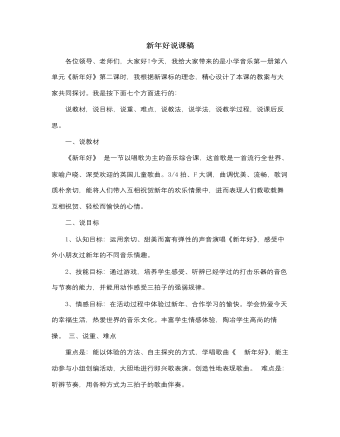
人音版小学音乐一年级上新年好说课稿
一、说教材《新年好》 是一节以唱歌为主的音乐综合课,这首歌是一首流行全世界、家喻户晓、深受欢迎的英国儿童歌曲。3/4拍、F大调,曲调优美、流畅,歌词质朴亲切,能将人们带入互相祝贺新年的欢乐情景中,进而表现人们载歌载舞互相祝贺、轻松而愉快的心情。二、说目标1、认知目标:运用亲切、甜美而富有弹性的声音演唱《新年好》,感受中外小朋友过新年的不同音乐情趣。2、技能目标:通过游戏,培养学生感受、听辨已经学过的打击乐器的音色与节奏的能力,并能用动作感受三拍子的强弱规律。3、情感目标:在活动过程中体验过新年、合作学习的愉快。学会热爱今天的幸福生活,热爱世界的音乐文化。丰富学生情感体验,陶冶学生高尚的情操。 三、说重、难点重点是:能以体验的方法、自主探究的方式,学唱歌曲《 新年好》,能主动参与小组创编活动,大胆地进行即兴歌表演。创造性地表现歌曲。 难点是:听辨节奏,用各种方式为三拍子的歌曲伴奏。
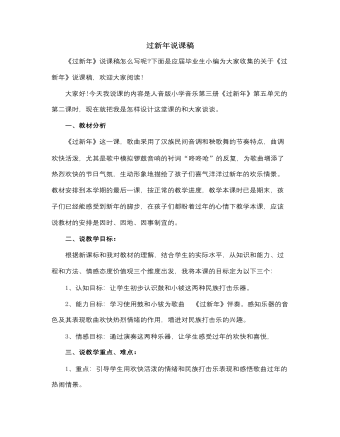
人音版小学音乐二年级上册过新年说课稿
经过“十”字步的学习知道东北秧歌的基本步伐。8、 演一演 让孩子们用舞蹈表现歌曲,拿起手帕扭秧歌、以及用打击乐器为歌曲进行伴奏,演示一遍,把全课推向高潮。七、教学启示总之,在本方案的设计中,我力求体现以人为本的思想,着眼于学生的主动发展,致力于运用现代信息技术优化课堂教学的研究,淡化学科边缘,通过充分的音乐实践培养学生的能力,提高音乐素养。依托音乐本身的魅力,影响学生人生观、审美观、价值观的形成。全面影响学生做人、做事的态度,培养学生主动学习、合作意识、探究精神。从目标的提出、到过程的安排、学习方法的确定、乃至学习成果的呈现,都让学生有更大的自主性、更多的实践性、更浓的创造性。当然,措施付诸实施,还需要老师的爱心和慧心,教学研究永无止境,我相信,没有最好,只有更好。在此,还请各位领导和同行们提出宝贵意见,谢谢!
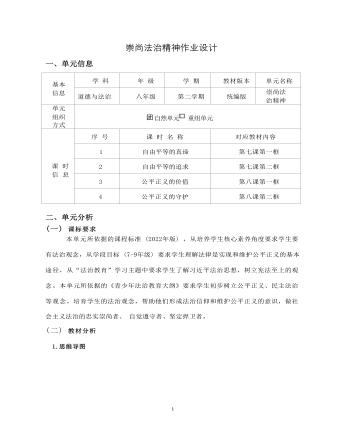
道德与法治八年级下册崇尚法治精神作业设计
6.公平是人类历史上一个永恒的主题。现实生活中我们也常常会遇到是否公平、如何 做到公平的问题。下列对公平理解正确的是( )A.公平就是多享受权利,少履行义务 B.公平就是绝对公平C.公平是一种较好的机遇和命运 D.公平意味着处理事情要合情合理7.2021年全国“两会”期间,“两会”特别节目《公平正义新时代》以案说法的同时, 还特别着重展示各部门如何履行职责守护社会公平正义。之所以关注公平正义,是因 为 ( )①正义是社会和谐的基本条件,能够为社会发展注入不竭的动力②公平是个人生存和发展的重要保障,是社会稳定和进步的重要基础③正义是社会文明的尺度,体现了人们对美好社会的期待和追求④公平的社会能为所有人提供同等的权利,从而激发自身潜能,提高工作效率 A .①②③ B .②③④ C .①③④ D .①②④8.教育部通知: 2018年全面取消体育特长生、中学生学科奥林匹克竞赛、科技类竞赛、 省级优秀学生、思想政治品德有突出事迹等全国性高考加分项目,这一规定 ( )
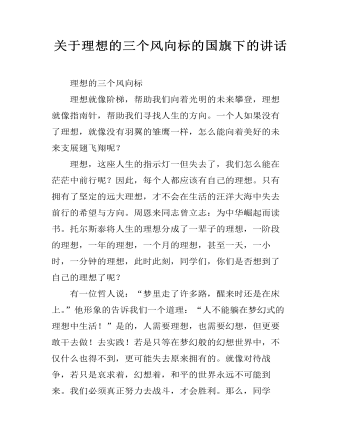
关于理想的三个风向标的国旗下的讲话
理想的三个风向标理想就像阶梯,帮助我们向着光明的未来攀登,理想就像指南针,帮助我们寻找人生的方向。一个人如果没有了理想,就像没有羽翼的雏鹰一样,怎么能向着美好的未来支展翅飞翔呢?理想,这座人生的指示灯一但失去了,我们怎么能在茫茫中前行呢?因此,每个人都应该有自己的理想。只有拥有了坚定的远大理想,才不会在生活的汪洋大海中失去前行的希望与方向。周恩来同志曾立志:为中华崛起而读书。托尔斯泰将人生的理想分成了一辈子的理想,一阶段的理想,一年的理想,一个月的理想,甚至一天,一小时,一分钟的理想,此时此刻,同学们,你们是否想到了自己的理想了呢?
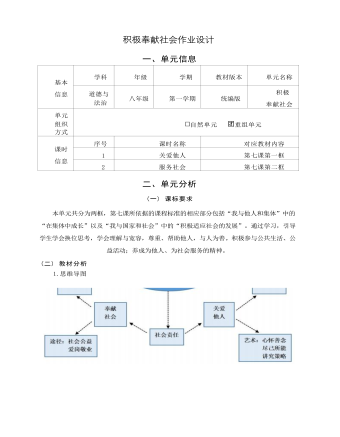
道德与法治八年级上册积极奉献社会作业设计
②服务和奉献社会需要我们青少年担当责任;服务和奉献社会需要我们积极参与社会 公益活动;服务社会,需要我们热爱劳动,爱岗敬业。答具体途径也可,如:环境保 护、社区服务、参加义务植树等。5.①我认为上述观点是正确的。②志愿服务可以体现人生价值,促进我们的全面发展。 一个人的价值不应该看他得到什么,而应该看他贡献什么。只有积极为社会做贡献, 才能得到人们的尊重和认可,实现自身价值。③通过开展志愿服务,承担社会责任, 可以发掘自身潜能,才能承担起时代和国家所赋予我们的使命,共享美好幸福生活。 ④在志愿服务的行动中,心怀善意、尽己所能、讲究策略的关爱他人,可以培养亲社 会行为,营造向上向善的社会和谐氛围。⑤服务社会的根本在于学习和践行。我们应 该从小事做起,从现在做起,在学习和实践中积极承担社会责任。⑥综上所述,志愿 服务正能量,勇担责任助成长。崇德向善新风尚,学习践行不能忘。
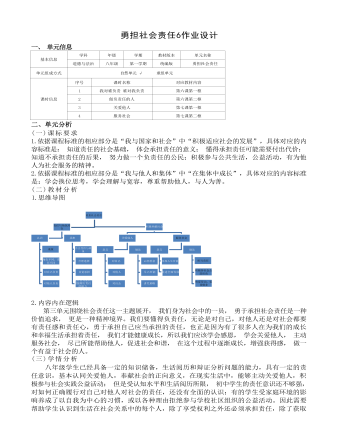
道德与法治八年级上册勇担社会责任6作业设计
8.“在前进的道路上, 我们搬开别人脚下的绊脚石有时恰恰是为自己铺路。”这告诉我们( )A.真诚的关爱都是为了补偿 B.关爱自己也就是关爱了他人C.关爱他人,也是关爱和善待自己 D.关爱他人不能获得任何帮助9.2021 年 5 月 10 日人民日报报道:陕西西安一饺子馆老板李恺一年多来坚持为困难人群提供 爱心餐,求助者只需报暗号“A 套餐”即可免费领取。李恺的行为( )A.自觉履行了法定义务 B.关爱了他人并且能讲究策略 C.是为了赢得他人赞许 D.体现服务社会需要爱岗敬业 10.全国“新时代好少年”小李长期积极参加首都博物馆、首都图书馆义务讲解, 以及社区绿 色低碳宣传活动, 组织同学为边远地区贫困小学捐赠衣物和书籍,帮助非洲儿童接种疫苗。 这启示我们要( )A.遵守制度,维护规则 B. 积极实践,服务社会C.走出国门,展示风采 D.努力学习,体味生活11.近年来, 感动中国人物已成为人民广泛学习的楷模。为了更好地传递这些人物身上的正能 量,我们要( )①热心公益,服务社会 ②积极承担责任,不言代价与回报③培养高度的社会责任感 ④从身边小事做起,只对自己负责
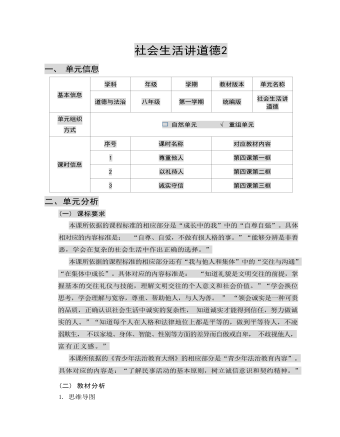
道德与法治八年级上册社会生活讲道德2作业设计
(一) 课标要求本课所依据的课程标准的相应部分是“成长中的我”中的“自尊自强”。具体 相对应的内容标准是: “自尊、自爱,不做有损人格的事。”“能够分辨是非善 恶,学会在复杂的社会生活中作出正确的选择。”本课所依据的课程标准的相应部分还有“我与他人和集体”中的“交往与沟通” “在集体中成长”。具体对应的内容标准是: “知道礼貌是文明交往的前提,掌 握基本的交往礼仪与技能,理解文明交往的个人意义和社会价值。”“学会换位 思考,学会理解与宽容,尊重、帮助他人,与人为善。 ” “领会诚实是一种可贵 的品质,正确认识社会生活中诚实的复杂性, 知道诚实才能得到信任,努力做诚 实的人。”“知道每个人在人格和法律地位上都是平等的,做到平等待人,不凌 弱欺生, 不以家境、身体、智能、性别等方面的差异而自傲或自卑, 不歧视他人, 富有正义感。”
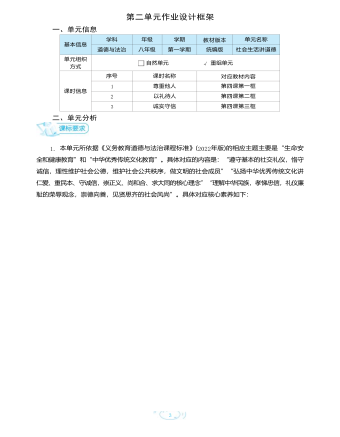
道德与法治八年级上册社会生活讲道德作业设计
2. 内容内在逻辑本课由引言和三框内容组成。引言首先指出道德是社会关系的基石,是人际和谐的基础,说明本课与单元主题之间的关 联 。随后,点出本课的三个主题:尊重他人、以礼待人、诚实守信。第一框“尊重他人”,用学生常见的两个场景引导体验,导入新课 。学生在理解尊重含义的 同时,懂得尊重对个人和社会的价值和意义,懂得尊重的复杂性;进而引导学生学会如何在实 际生活做到尊重他人。第二框“以礼待人”,引导学生探讨文明有礼对个人和社会的意义,再扩展至“礼仪之邦”的 国家形象,懂得参加各种仪式体现了民族的尊严和国家的形象。第三框“诚实守信”,首先使学生明白诚信是一种道德规范,也是社会主义核心价值观在公 民个人层面的一个价值准则,在学生体会和认识到诚信对个人、社会等重要影响的基础上,引 导学生不断增强诚信意识,积极参加诚信建设。
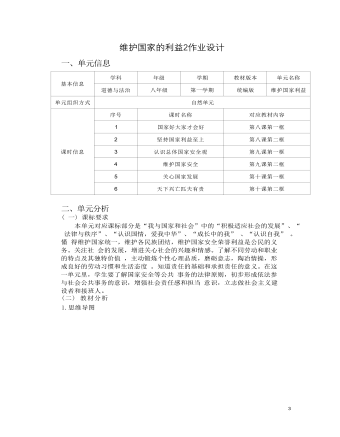
道德与法治八年级上册维护国家利益2作业设计
2. 内容内在逻辑第八课《国家利益至上》设计了“国家好,大家才会好”“坚持国家利益至 上”两框内容,其立意在于帮助学生认识维护国家利益的重要性,正确认识国家 利益与人民利益的关系,提高维护国家利益的意识,树立正确的国家利益管,提 高辨析各种爱国观念和行为的能力,使自己的爱国情感更加理性、深沉。第九课《树立总体国家安全观》设计了“认识总体国家安全观”和“维护国 家安全”两框。 目的在于引导学生正确理解和全面把握我国安全形势面临的挑战 ,从小树立总体国家安全观, 自觉担负起维护国家安全的责任。第十课《建设美好祖国》设计了“关心国家发展”“天下兴亡,匹夫有责” 两框内容,其目的和意图在于帮助学生全面认识国家发展,从初中学生的角度认 识祖国发展,正视国家发展过程中的问题,理解自己与国家发展的密切关联,让 学生在关心祖国发展的同时,为将来投身于国家建设奠定认识基础。
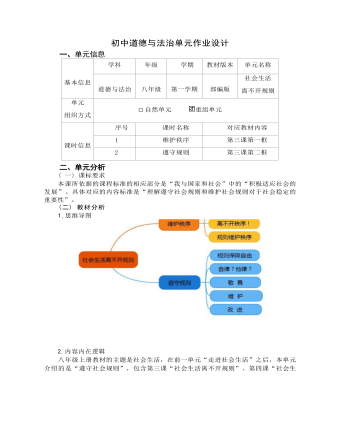
道德与法治八年级上册社会生活离不开规则作业设计
材料一 近年,外形酷似汽车的代步车大量上路,他们无牌、无照,走机动车道、 闯红灯,逆行、随意抢道、并线,不仅给城市交通带来压力,也造成不少安全隐患。材料二 斑马线上礼让行人已成为常态,大部分行人在遇到车辆礼让时,都能自 觉快速通过,但仍有部分行人“ 目中无车”——边过马路边看手机,或以散步的速度 缓慢通行,还有一些人在等候的机动车间任意穿行。让行司机表示:很苦恼也很无奈。(1) 你如何看待闯红灯、逆行、随意抢道、并线等交通陋习?(2) 针对部分行人“ 目中无车”,你会如何劝说他们遵守交通规则?(3)请你为杜绝交通陋习提两条合理化建议。(可从国家及相关部门、社会、公 民等角度提建议)12.阅读材料,回答下列问题。邮轮旅游作为现在新兴旅行方式之一,很多国人还并不习惯,有的游客因为不懂 邮轮规则而“露怯”,有的游客因为不遵守规则而影响到他人。






